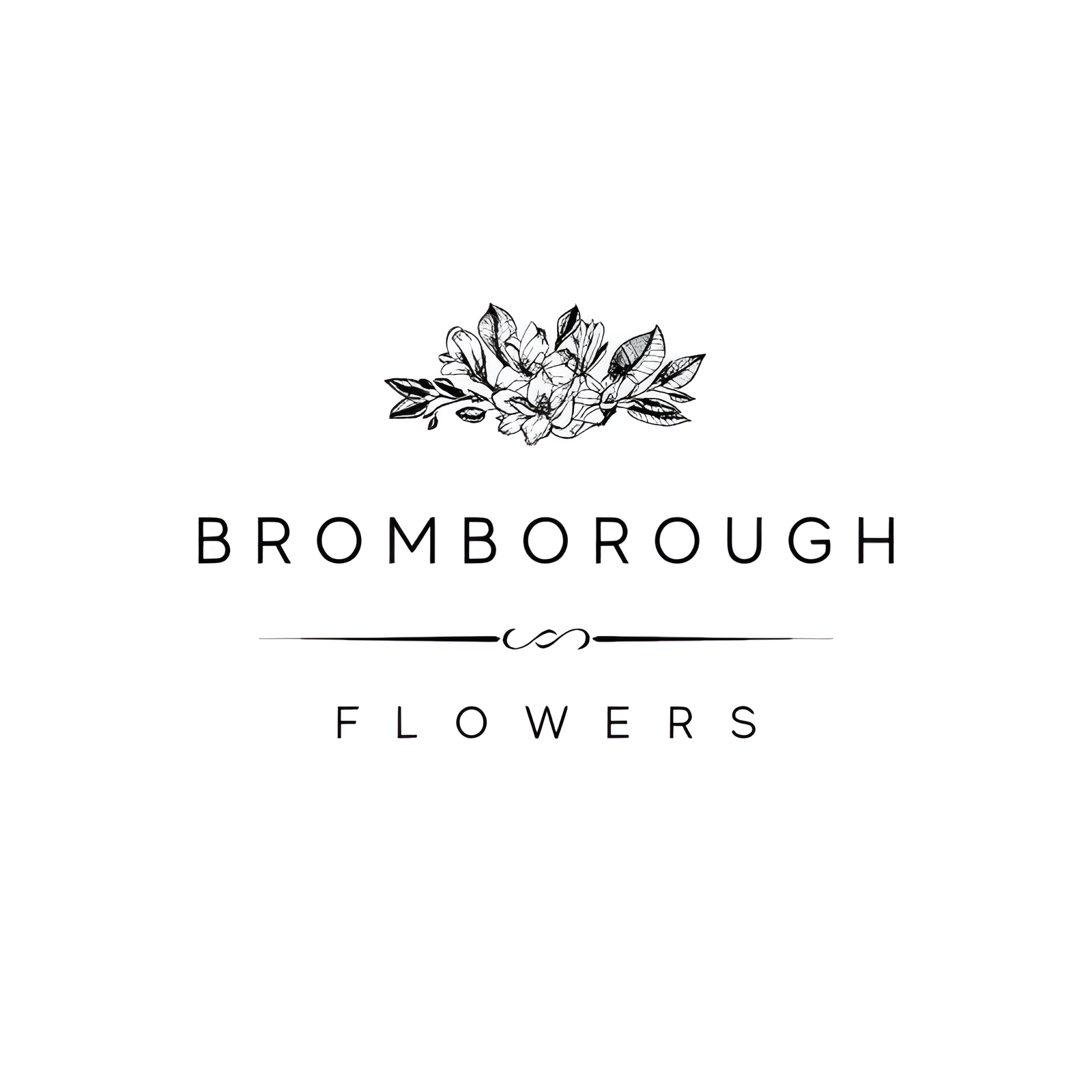In the world of wedding florals, the thistle stands out as a distinctive choice that marries elegance with a touch of rustic charm. Known for its striking blue blossoms and textured foliage, this flower is not only visually appealing but also rich in symbolism, representing admiration and independence. Its versatility allows it to seamlessly fit into various wedding themes, from modern to whimsical. For those considering incorporating thistles into their wedding arrangements, understanding its physical characteristics, cultural significance, and ideal growing conditions is essential. What makes this flower truly special in the context of matrimonial celebrations?
Flower Overview
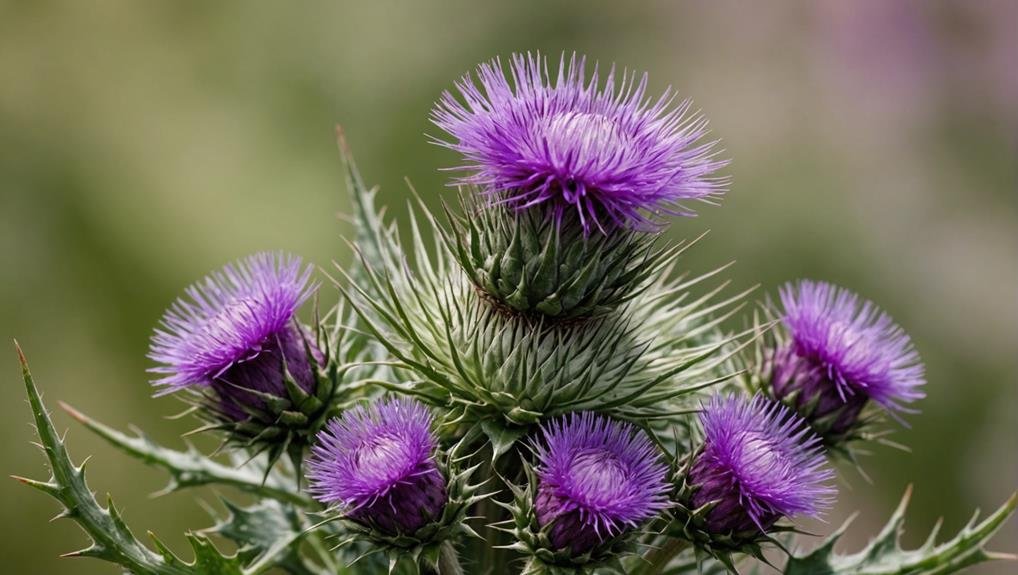
Blue thistles, originating from Eastern Europe, are distinctive flowers known for their blue-gray, snowflake-shaped leaves and ability to thrive in sandy fields with full sun exposure. These resilient plants have adapted to various environments, including those found across the United States, making them a popular choice for gardeners and florists alike. Their hardy nature allows them to flourish with minimal water, multiplying rapidly and providing a sustainable option for eco-conscious floral designs.
Blue thistles are particularly valued in the domain of DIY floral arrangements for weddings. Their unique texture and striking blue hues add depth and interest to bouquets, boutonnieres, and corsages. The versatility of blue thistle varieties, such as Aquarius Questar, Blue Bell, and Sea Holly, offers a range of shades and characteristics to suit different design aesthetics. These flowers are not only visually appealing but also long-lasting, ensuring that arrangements maintain their beauty throughout the event.
Incorporating blue thistles into wedding decor can elevate the overall ambiance, providing a touch of elegance and natural beauty. Their distinctive appearance and durability make them an excellent choice for anyone looking to create memorable and stunning floral arrangements.
Physical Description
Characterized by their thorny blue flowers and blue-gray, snowflake-shaped leaves, thistles stand out as a visually striking and texturally unique addition to floral arrangements.
Blue thistles, particularly varieties such as Sea Holly, are native to Eastern Europe but have since spread to various regions in the United States. These resilient plants thrive in sandy fields with full sun exposure and minimal water, making them an excellent choice for low-maintenance gardening.
Blue thistles produce distinct, spiky blossoms that contribute a bold, architectural element to any floral design. Their blue-gray foliage adds a contrasting softness, enhancing the overall visual appeal.
The plant’s unique structure and coloration make it an ideal candidate for textured blue-colored floral designs, offering a striking complement to more traditional wedding flowers.
Sea Holly, a popular variety, exemplifies the thistle’s characteristic thorny texture and vibrant blue hue, making it a favored choice for both garden cultivation and floral arrangements.
When paired with companions like white phlox and snapdragons, blue thistles create a harmonious and visually dynamic display. This combination not only highlights the thistle’s unique features but also enhances the overall aesthetic of any floral composition.
Available Colour Varieties
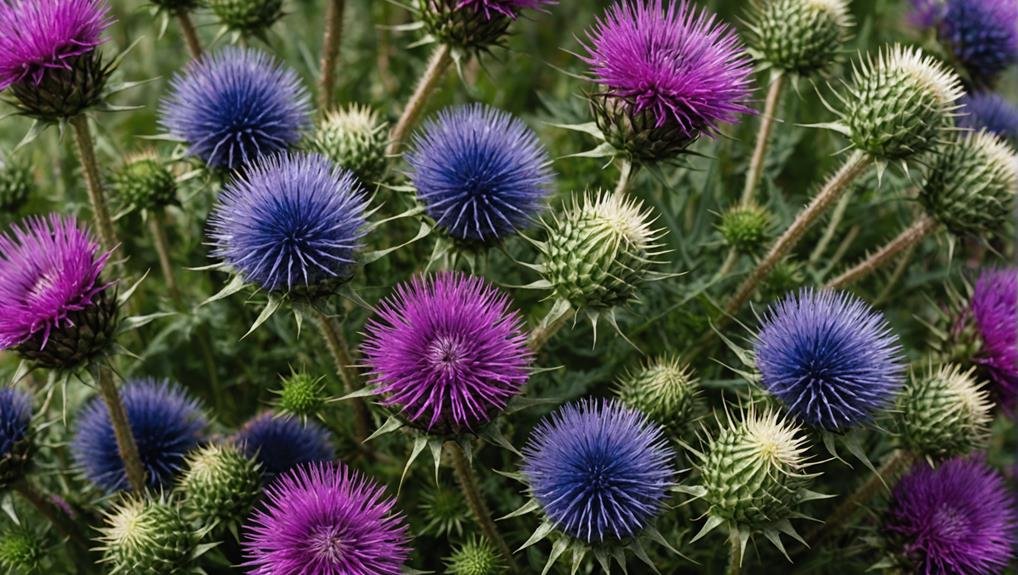
Thistle flowers are available in a variety of hues, including multiple shades of blue and purple, providing a unique and vivid color palette for floral arrangements. These colors can range from deep, rich purples to lighter, more whimsical blues, making them an excellent choice for adding a splash of color to wedding decor.
The versatility of thistle flowers concerning color makes them suitable for a wide array of wedding color schemes, from modern and sleek to rustic and charming.
In addition to their striking colors, thistles come in various sizes and shapes, featuring their iconic snowflake-shaped leaves and thorny blooms. This diversity further enhances their appeal in DIY flower projects, where their unique textures can add depth and visual interest to bouquets, centerpieces, and other arrangements.
The distinct hues of blue and purple thistles can be paired with other flowers to create stunning contrasts or harmonious blends, depending on the desired aesthetic.
Furthermore, blue thistles symbolize admiration, austerity, independence, and nobility, adding a layer of meaning to wedding arrangements. Their versatile color range and symbolic significance make them a popular choice for modern, rustic, and whimsical wedding themes alike.
Latin Name and Taxonomy
Known scientifically as ‘Cirsium,’ thistles belong to the Asteraceae family, which encompasses over 200 species worldwide. The Latin name ‘Cirsium’ is derived from the Greek word ‘kirsos,’ meaning swollen vein, a reference to the plant’s traditional use in treating such conditions. Thistles are classified as flowering plants distinguished by their spiny leaves and prickly stems, characteristics that lend a unique texture to floral arrangements.
In terms of taxonomy, thistles are placed within the order Asterales and the family Asteraceae, also known as the daisy or sunflower family. This family is one of the largest in the plant kingdom, renowned for its composite flowers. The genus Cirsium, specifically, includes a wide variety of species, each showcasing vibrant and distinctive flowers. These species are often used in wedding bouquets and centerpieces for their striking appearance and intriguing form.
The prickly nature of thistles, combined with their vivid blooms, makes them an interesting addition to any botanical taxonomy. Their complex structure and diverse species range contribute significantly to their popularity.
Understanding the Latin name and taxonomy of thistles provides valuable insight into their unique characteristics and botanical significance.
Geographical Origins
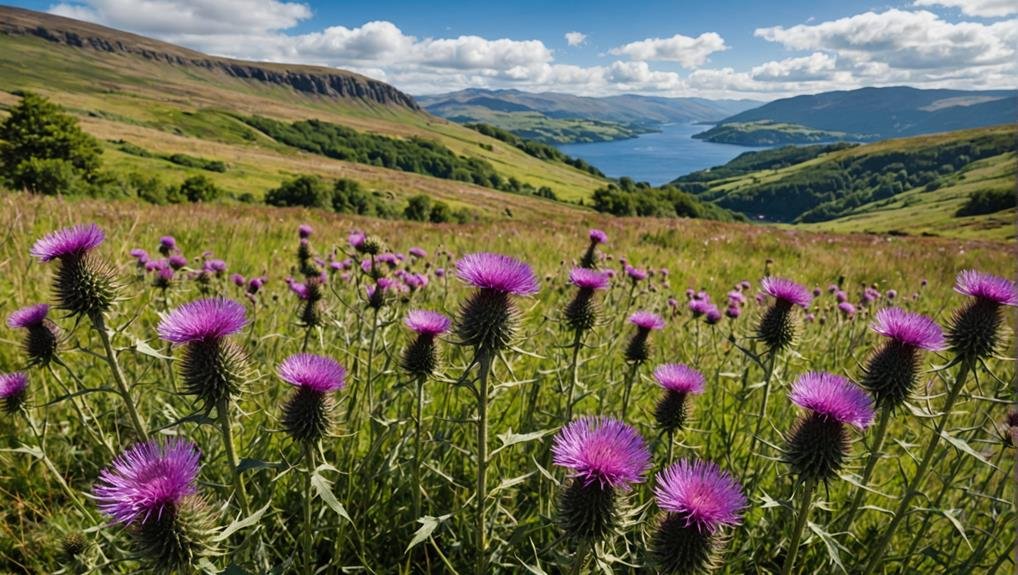
Originating in Eastern Europe, blue thistles have since spread to various regions, including the United States, where they thrive in sandy fields with abundant sunlight. These hardy plants have adapted well to diverse environments, demonstrating remarkable resilience. Blue thistles require minimal water, although they can multiply rapidly with increased moisture, making them a versatile addition to various landscapes.
The geographical origins of blue thistles have notably influenced their distribution and growth patterns. In Eastern Europe, they were first admired for their unique thorny blue flowers and blue-gray snowflake-shaped leaves. Over time, their aesthetic appeal and low maintenance needs led to their introduction in North America. In the United States, blue thistles grow wild across several states, particularly in areas that provide the full sun exposure they need to flourish.
| Region | Characteristics |
|---|---|
| Eastern Europe | Native habitat, original growth |
| United States | Sandy fields, full sunlight |
| Various States | Rapid multiplication |
| Diverse Environments | Low water requirements |
Blue thistles’ ability to thrive in different geographical regions makes them an ideal choice for textured blue-colored floral designs. Their striking appearance adds a distinctive element to wedding arrangements, highlighting their broad adaptability and enduring appeal.
Season Availability
Due to their ability to bloom throughout the year, blue thistles provide a consistent and versatile option for wedding floral arrangements regardless of the season. This perennial presence guarantees that couples can incorporate these striking flowers into their wedding decor no matter the time of the year, making thistle a reliable choice for florists and event planners.
The season availability of thistle is one of its most attractive features, as it can be sourced and utilized in any month. This characteristic is particularly advantageous for weddings, where floral consistency is vital for maintaining the envisioned aesthetic. Varieties such as Aquarius Questar, Blue Bell, Sea Holly, Cirsium, and Dynamite offer a range of shades and forms, providing ample creativity in design while ensuring year-round accessibility.
Thistles thrive in a variety of growing conditions, which contributes to their robust availability. While other flowers may be limited by seasonal patterns, thistle remains unaffected, offering a unique, thorny blue bloom that complements numerous wedding themes.
For couples seeking a resilient and visually compelling floral element, the enduring season presence of thistle makes it an ideal choice for wedding arrangements throughout the year.
Growing Conditions
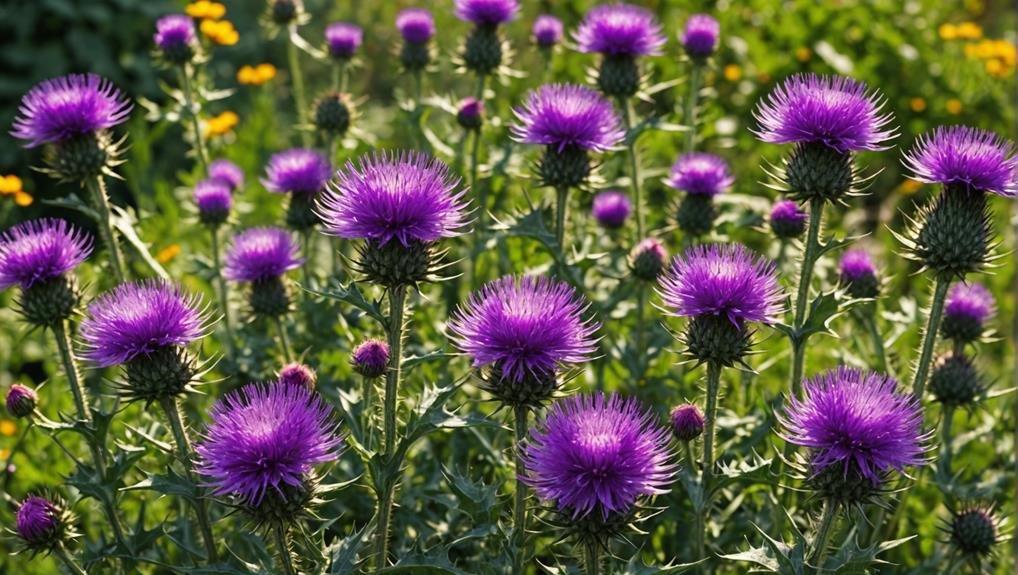
Blue thistles flourish in sandy fields with abundant sunlight, adapting well to different growing conditions. Originating from Eastern Europe, these resilient flowers are recognized for their distinct thorny blue blossoms and blue-gray, snowflake-shaped leaves. They need minimal water, making them an excellent choice for low-maintenance gardens. However, it should be noted that they can multiply rapidly with increased moisture.
To promote optimal growth for blue thistles, consider the following essential growing conditions:
- Sunlight: Blue thistles require full sun exposure for a minimum of six hours daily to achieve their peak bloom.
- Soil Type: They prefer sandy or well-drained soil, resembling their natural habitat.
- Watering: While they are drought-resistant, moderate watering can assist in their initial establishment.
- Companion Plants: Suitable garden companions include white phlox and snapdragons, which enhance the blue thistle’s striking appearance.
Varieties like Aquarius Questar, Blue Bell, Sea Holly, Cirsium, and Dynamite offer diverse shades and characteristics, catering to different landscaping requirements.
Cultural Significance
Thistle has long held a prominent place in Celtic culture, symbolizing bravery, courage, and resilience. Its significance is deeply rooted in the highland landscapes of Scotland and Ireland, where it has been revered for centuries. The thistle’s hardy nature, requiring minimal water and thriving in less-than-ideal conditions, mirrors the strength and fortitude celebrated in Celtic traditions.
In the rich tapestry of Celtic symbolism, the thistle stands out as a powerful emblem of overcoming adversity. The plant’s prickly exterior and vibrant bloom are metaphors for the challenges faced and conquered, embodying the spirit of determination and protection. This symbolism has been woven into various aspects of Celtic heritage, including folklore, art, and even national iconography, with Scotland adopting the thistle as its national flower.
Emotional significance is another layer to the thistle’s cultural importance. In Celtic traditions, it is often associated with personal challenges and the inner strength required to overcome them. This profound connection to resilience and bravery makes the thistle not only a symbol of national pride but also a personal emblem for individuals facing their own struggles. Its distinctive appearance and deep-rooted symbolism secure its enduring legacy in Celtic culture.
Typical Use in Weddings
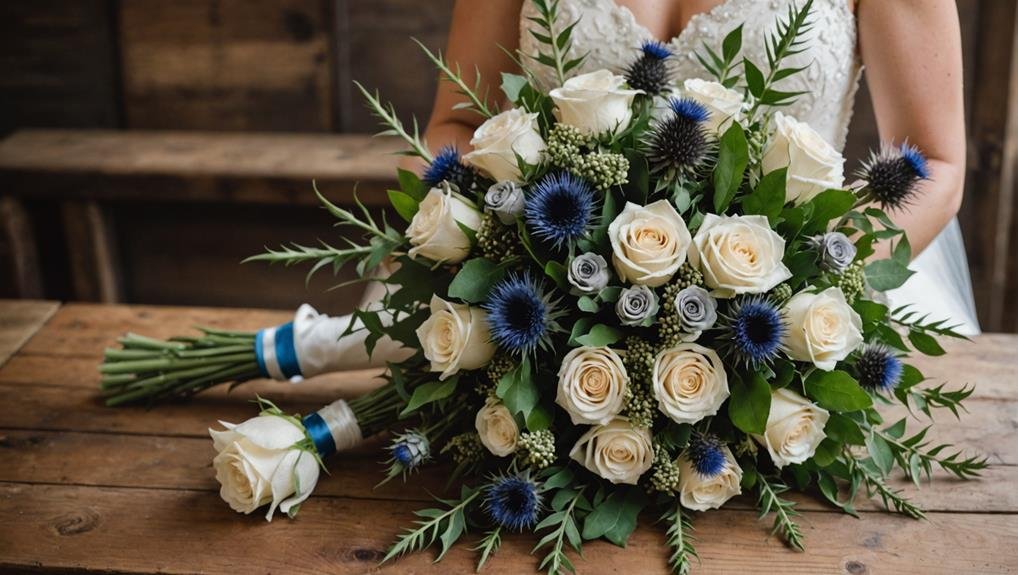
In wedding florals, thistle flowers are prized for their ability to add texture, color, and a touch of uniqueness to bouquets and arrangements. Their symbolic meanings of admiration, austerity, independence, and nobility make them a fitting choice for a variety of wedding themes, from modern to rustic to whimsical. The unique appearance of thistles enhances the overall aesthetic, providing a striking contrast to more traditional blooms.
Thistle flowers are versatile in their applications, seamlessly fitting into various components of wedding floral arrangements. Here are four popular ways to incorporate thistles into wedding decor:
- Bouquets: Thistles add depth and texture, making bridal and bridesmaid bouquets visually enchanting.
- Centerpieces: These flowers can serve as focal points or accents in table centerpieces, contributing to an elegant and cohesive look.
- Boutonnieres: Thistles’ compact size and sturdy structure make them an excellent choice for boutonnieres, adding a unique touch to the groom and groomsmen’s attire.
- Bud Vases: Placing thistles in bud vases scattered throughout the venue creates a cohesive and stylish atmosphere.
With a long vase life of 7-10 days, thistle flowers guarantee that wedding decorations remain fresh and vibrant throughout the celebration, solidifying their status as a favored wedding flower.
Alternative Flower Types
For couples seeking variety in their wedding florals, several alternative flower types offer unique textures and vibrant colors to enhance the overall decor. Dianthus Green Trick, known for its vibrant green texture, adds a fresh and modern touch to any arrangement, available from $32.92 per bunch.
Rose Voodoo Orange, with its striking orange blooms, can be an eye-catching centerpiece, priced at $3.39 per stem, making it a versatile option for both formal and DIY Floral setups.
Kochia is another excellent choice for those desiring a unique foliage option. Its versatility makes it suitable for various arrangements, starting from $23.80 per bunch.
For couples looking to add a touch of elegance to their wedding, the Garland Seeded Eucalyptus & Olive, priced at $108.65 for an 8-foot length, is perfect for draping over arches or decorating tables.
Lastly, Snapdragon Purple Flowers offer an elegant burst of purple, enhancing the color palette of any wedding decor. These blooms start at $33.76 per bunch, providing a sophisticated option for both bouquets and centerpieces.
Each of these alternative flower types can elevate your wedding with their distinct charm and beauty.
